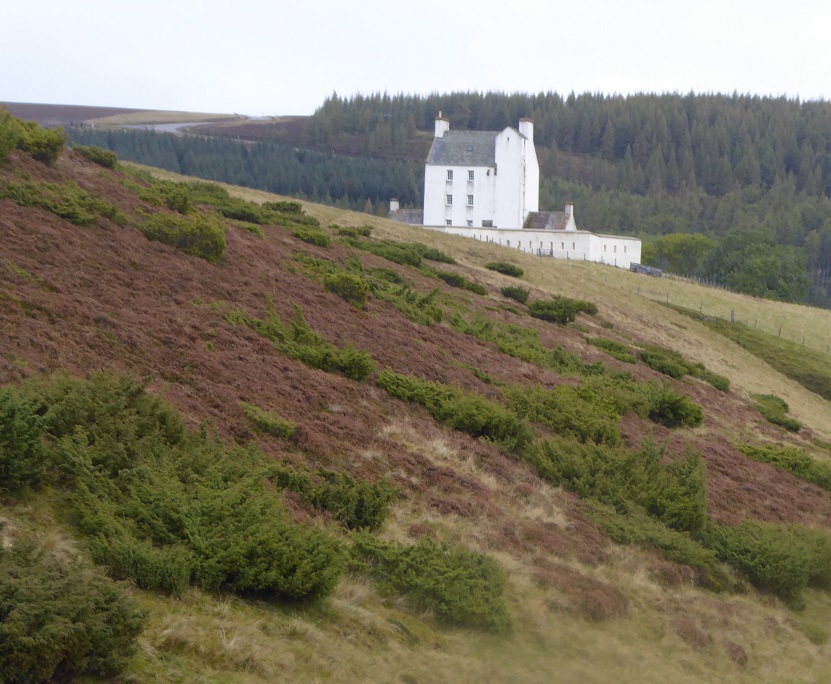
In October I went for a walk over Brown Cow Hill on the Delnadamph Estate, which was bought by the Queen in 1978 and gifted to Prince Charles on his marriage to Diana. I had not been for many years but was keen to see how the estate was being managed given Prince Charles’ role and his statements about conservation. For example :
“I am proud to be president of WWF. I have long admired its efforts to tackle the many threats to the world’s wildlife, rivers, forests and seas. And I have come to see how effectively it uses its expertise and international reach to challenge the causes of degradation, such as climate change and the unsustainable use of natural resources. It is important work – after all, our natural world is the most precious asset we have.”
HRH The Prince of Wales, WWF-UK President (see here)
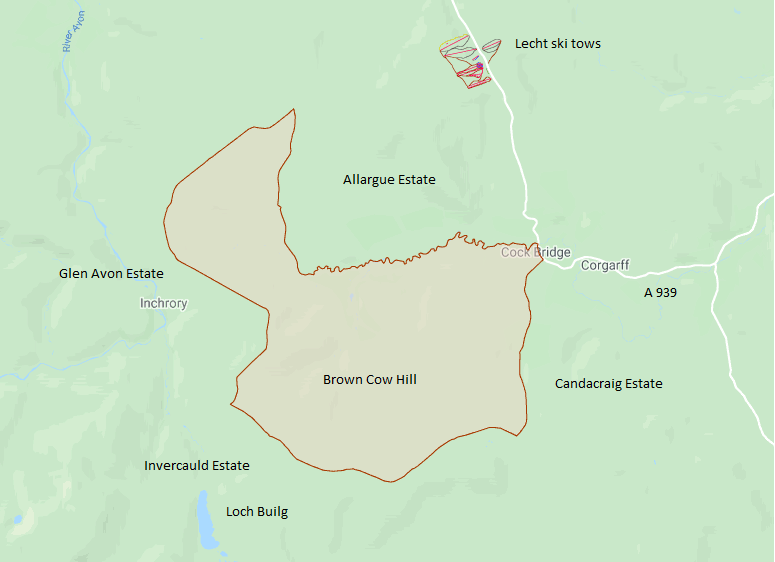
Delnadamph is not a big estate, about 6,700 acres on the northern flank of Brown Cow Hill. It is curiously shaped and about as far from the sea as you can get in Scotland, being located near the source of the River Don. It was purchased apparently because there was not enough land for grouse shooting at Balmoral (8 miles to the south) and I was interested to see what impact this was having on the natural environment, the forests, wildlife and rivers Prince Charles claims to care about.
Forest and muirburn
There was not much sign of woodland on the estate, let alone forest.
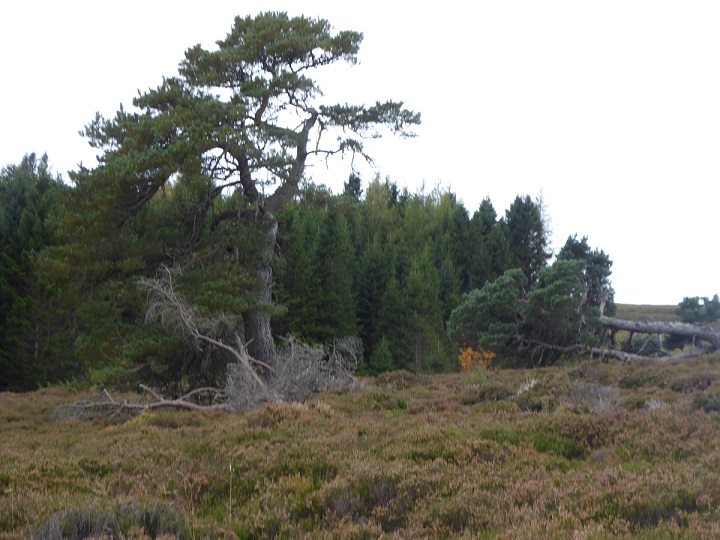
The two old pines we saw walking up the Cock Burn appeared on their last legs and the plantation behind had been reduced in size to little more than an isolated stand of trees. That was the only woodland we saw on the estate until back down near Inchmore, where my OS Map, revised in 2010, shows another plantation.
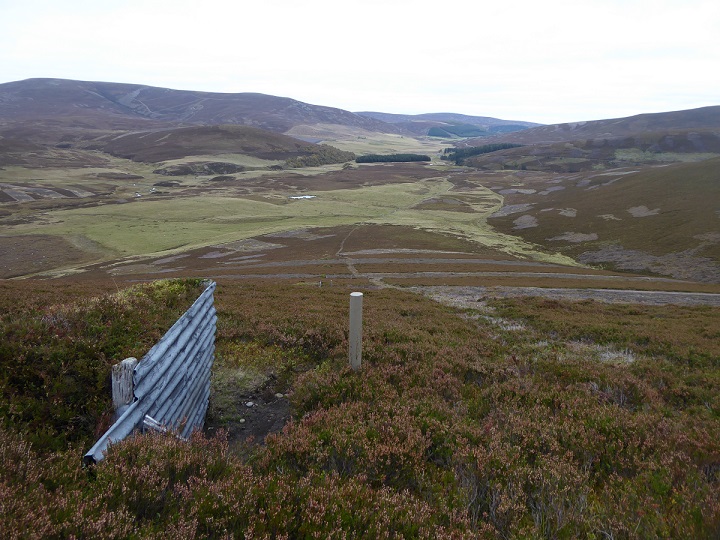
The plantation at Inchmore used to extend to the green strip, top right, but it is now, as you can see from the muirburn, managed as grouse moor.
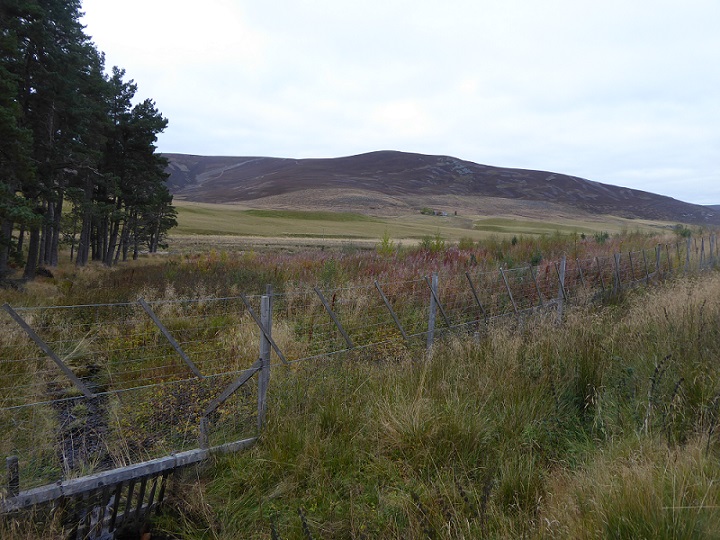
Apart from some policy woodlands around the buildings at Delnadamph (left), the only area we saw that was managed as woodland was a narrow strip between the road and River Don where native trees had been planted. Delnadamph must be one of the least forested estates in the Cairngorms National Park. It is managed as part of the Balmoral Estate and is also part of the East Cairngorms Moorland Partnership (ECMP), the Cairngorms National Park Authority’s preferred vehicle for improving conservation on grouse moors.
According to the final report of the Cairngorm Nature Action Plan 2013-18 one of the aspirations of the ECMP was:
“woodland expansion – using opportunity mapping, seeking to increase the woodland cover over the six estates from the current average of 14%”
From looking at maps, I doubt Delnadamph reaches 5%. Apart from the small enclosure there was no evidence of anything being done to change that.
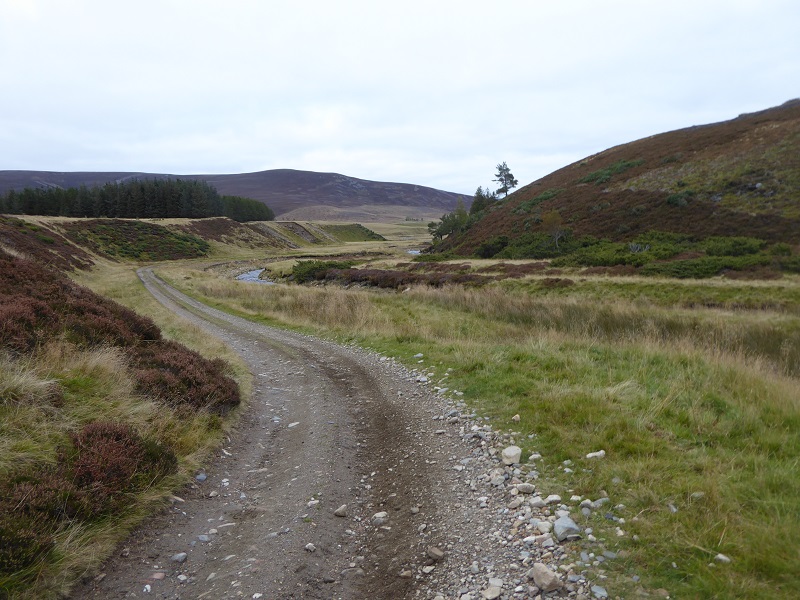
The potential, however, is huge. The soils on the Don are generally better than on the Dee and juniper, one of Scotland’s three native conifers, colonises the ground easily. Unfortunately it is being burned before it can provide cover for songbirds or even other “game” birds like black grouse or woodcock.
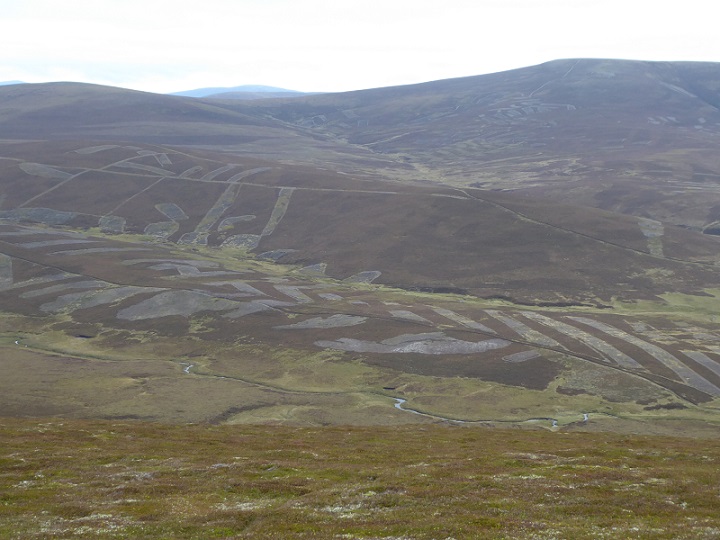
It seems that Delndamph is only interested in red grouse.The CNPA has an aspiration to join up woodland across the main watersheds of the Cairngorms. There is not at chance of that happening while the land is burned like this.
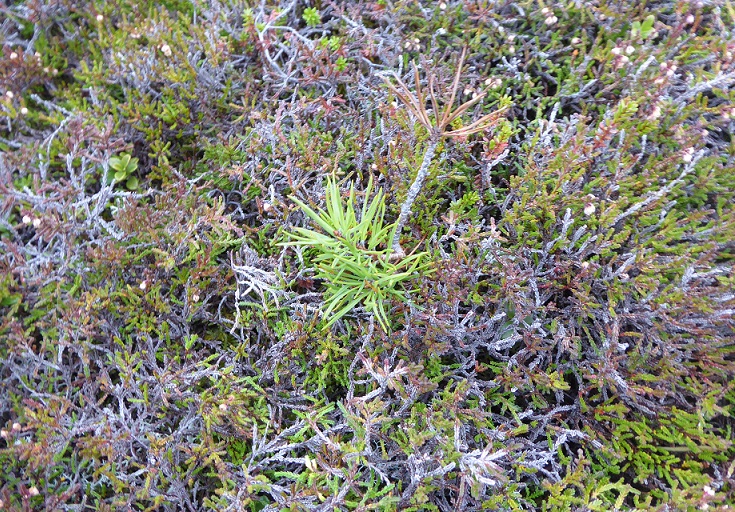
After c12 km of tramping the high ground we even spotted a lone pine seedling at over 700m on the ridge between Little Geal Charn and Cairnculchavie, near the Well of Don, the source of that river and miles from any seed source. But what chance has it got when all the middle ground is burned?
What’s happening is best viewed on google earth (see here):

In much of the Cairngorms it is high deer numbers that prevent woodland regeneration, but not at Delnadamph. Lengthy deer fences split the Upper Deeside and Donside Deer Management Group (see here) into a western half, where in 2016 deer density was 8.51 per square kilometre, compared to 0.36 deer per square kilometre on the eastern half.
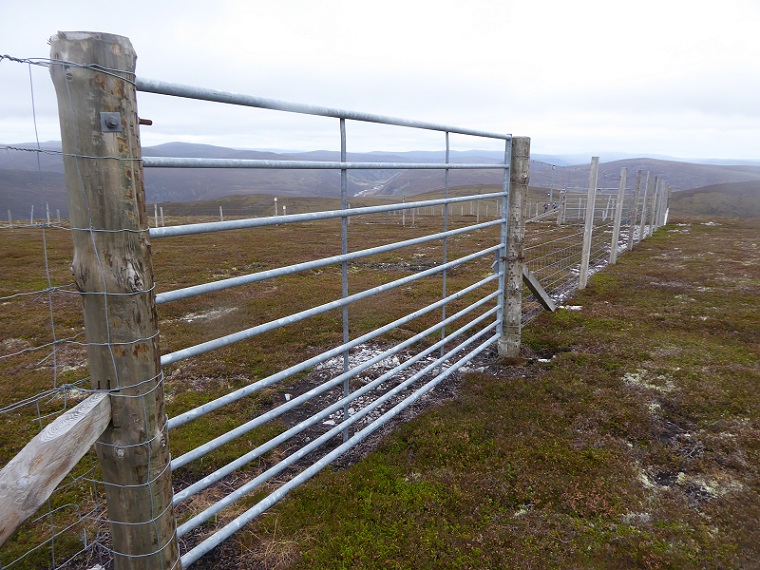
While it varies slightly from year to year, Delnadamph now has few or no deer:
 Delnadamph certainly has fewer deer than Glen Feshie which now has approximately two deer per square kilometre and where natural regeneration of the woodland is fantastic. There are some sheep, probably being used to mop up ticks that infect the grouse, but these would be easy enough to remove:
Delnadamph certainly has fewer deer than Glen Feshie which now has approximately two deer per square kilometre and where natural regeneration of the woodland is fantastic. There are some sheep, probably being used to mop up ticks that infect the grouse, but these would be easy enough to remove:
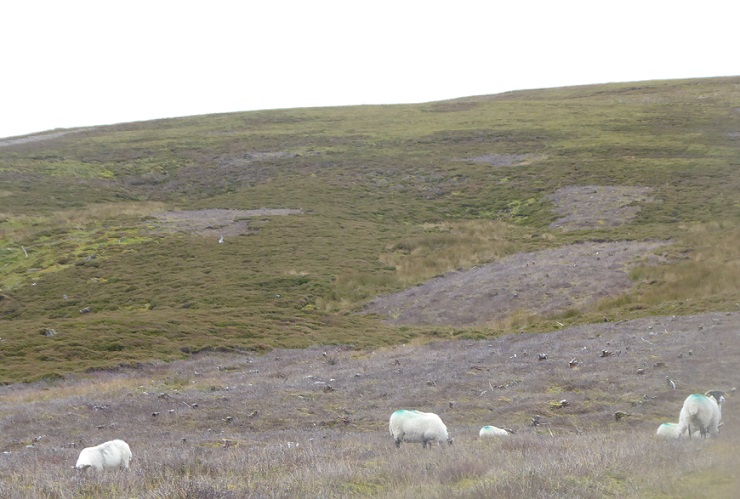
In conservation terms, all sorts of exciting things could be happening if it was not for the muirburn. And, unlike neighbouring areas, none of the moor has been fossilised by EC designations, so it could be left to regenerate naturally. All it would take is a word from Prince Charles.
Wildlife
Apart from sheep, the main animals we saw were red grouse. I hesitate to call them wild and not just because of intense management of heather designed to provide them with food. All over the hill there were “stations” with grit.
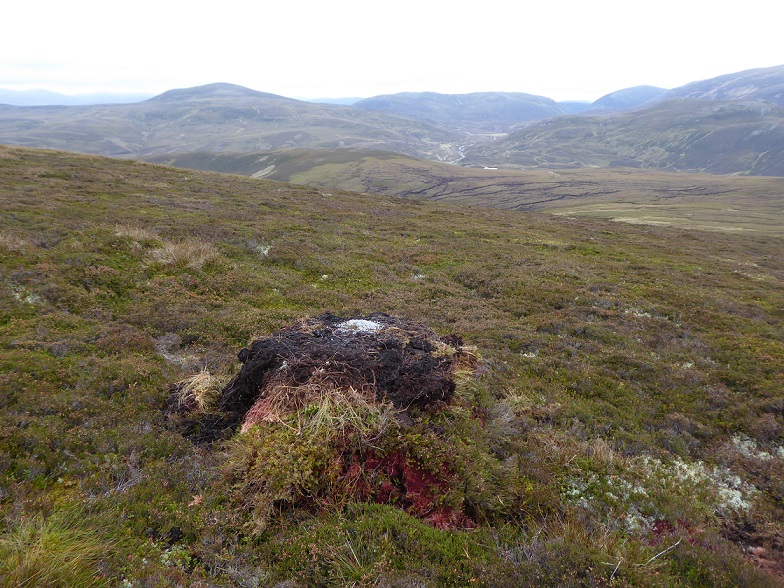
I assumed the grit was medicated, as per the normal practice, but perhaps Prince Charles’s red grouse at Delnadamph are organic, like his farm in Devon which he gave up earlier this year (see here)? If so, he should be calling for his neighbours to do the same. Unregulated medication of animals should have no place in a National Park.
I failed to see a single mountain hare, although two of our party who were ahead at one point saw three.
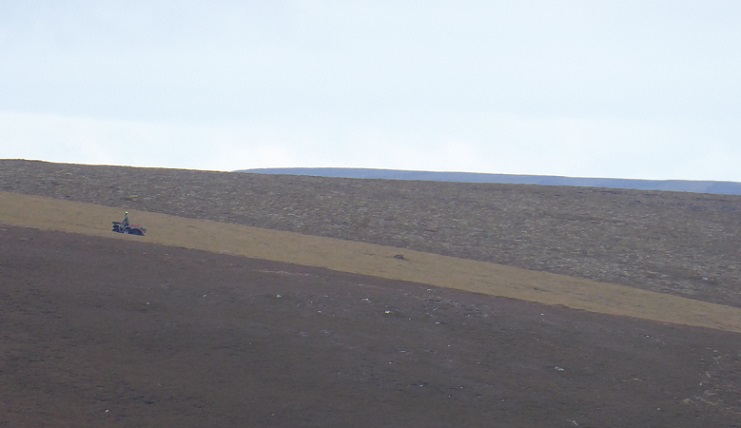 For a couple of hours there was an ATV on the hill, which I assumed was mainly being used to replenish grit stations as it kept starting and stopping, although we also heard three shots. It is hard to imagine what the keeper was shooting unless mountain hare. Given public concern on the subject, perhaps Prince Charles or the Cairngorms National Park Authority could clarify whether mountain hare are shot at Delnadamph or not? There was certainly very little food for eagles to eat apart from red grouse, although high levels of raptor persecution on Donside (see here) is probably the reason we failed to see any. .
For a couple of hours there was an ATV on the hill, which I assumed was mainly being used to replenish grit stations as it kept starting and stopping, although we also heard three shots. It is hard to imagine what the keeper was shooting unless mountain hare. Given public concern on the subject, perhaps Prince Charles or the Cairngorms National Park Authority could clarify whether mountain hare are shot at Delnadamph or not? There was certainly very little food for eagles to eat apart from red grouse, although high levels of raptor persecution on Donside (see here) is probably the reason we failed to see any. .
I kept an eye out for traps all day and was about to remark how pleasantly surprised I was not to have seen any when I spotted this one hidden by the road:
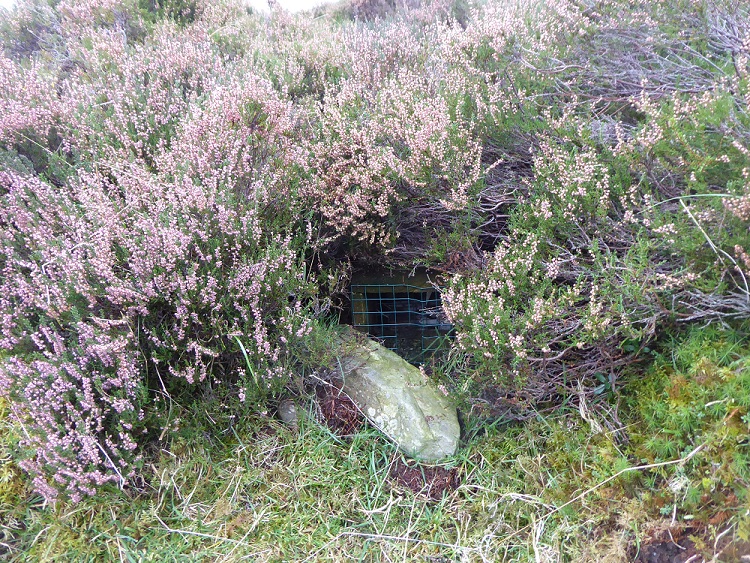
We had probably not been looking carefully enough or wandered in the places were traps are placed. But maybe I am doing HRH and President of the WWF a dis-service and he will declare I stumbled across the one and only trap at Invercauld?
Rivers
I am afraid I did not have time to take a closer look at the Don, which forms the northern boundary of the estate. What I can say with confidence, however, is that all the muirburn on the estate helps water run off the hill and will contributing to flooding lower down the Don. While parkswatch has been critical of the postage stamp sized planting along rivers on Deeside – it’s not nearly enough – there are even fewer trees on the Delnadamph side of the upper stretches of the Don.
Other conservation issues – peat bog and tracks
While Brown Cow Hill is sometimes said to be a boring from a hillwalking perspective, the views over to Ben Avon are fantastic and there is some fine bog. From the 1960s various attempts, often paid for by public money, were made to drain bogs to “improve” the land:

The Scottish Government is now investing significant sums of money to restore damaged areas of bog to lock up carbon and this includes blocking up grips. While it sticks in the craw to pay landowners to undo the damage they have done it can never compensate for all the oil that is still being extracted in the North Sea, peat bog restoration is a reasonable idea in principle. The Peatland Action Project, which now has a staggering £250m to invest over the next ten years (see here), needs to be careful not to “repair” damage which nature is in the process of fixing anyway. Nor is there any point in Peatland Action paying to restore particular areas of damaged bog unless the landowner concerned stops damaging land-management activities elsewhere on their estate.
In the Cairngorms a significant proportion of the Peatland Action monies is being directed at the seven estates in the East Cairngorms Moorland Partnership, including Delnadamph.
“By the end of 2018, peatland restoration work had been carried out on nearly 700 ha of degraded peatland on ECMP estates, which corresponds to an estimated saving of 8,667 tonnes of CO2 per year. During 2019, five projects, on four estates (Mar, Invercauld, Mar Lodge & Balmoral), covering 267 ha were awarded funding from Peatland Action but a lack of contractor capacity meant that only two projects started and winter weather has prevented the completion of both of these. All five projects are being carried forward and new projects will be developed with Glenavon, Balmoral (Delnadamph) and Glenlivet estates”.
On Brown Cow Hill, besides the drainage ditches, some of which appear to be blocking up naturally, there are several areas of eroding peat which could also have been identified by Peatland Action for restoration work:
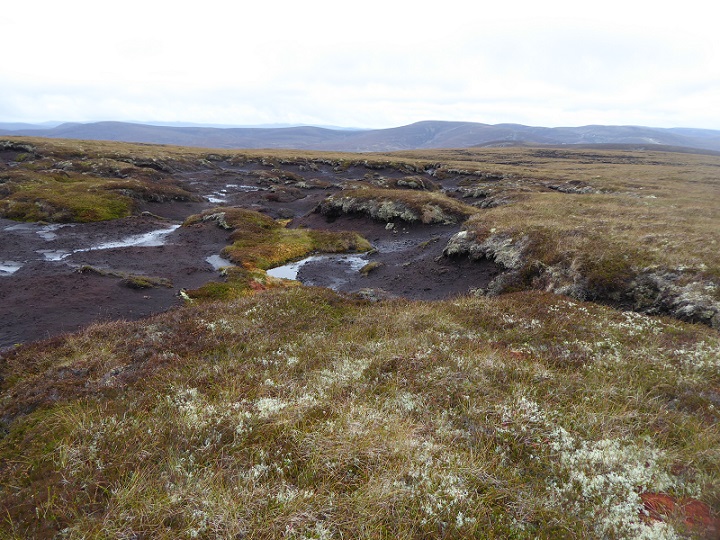 There is a thorny question here, which in my view needs to be addressed publicly, about the extent to which exposed peat hags such as this are the result of “damage” or natural processes.
There is a thorny question here, which in my view needs to be addressed publicly, about the extent to which exposed peat hags such as this are the result of “damage” or natural processes.
What was clear from our walk, however, was that management activities currently being carried out on the estate are damaging areas of bog.
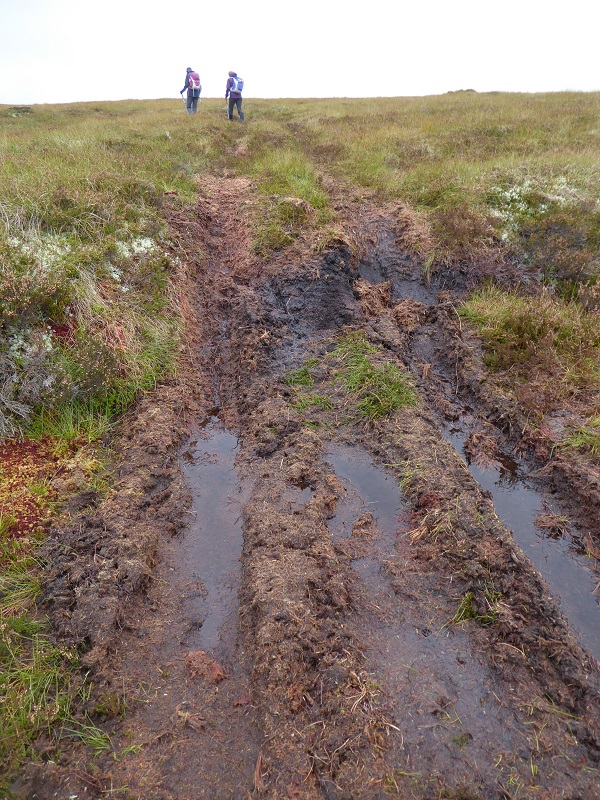
There are All Terrain Vehicles churning up vegetation and peat. This appears to be a particular problem on lines linking grouse butts, so appears being caused by grouse shooters who are either not able or not prepared to walk up the hill to the butts.
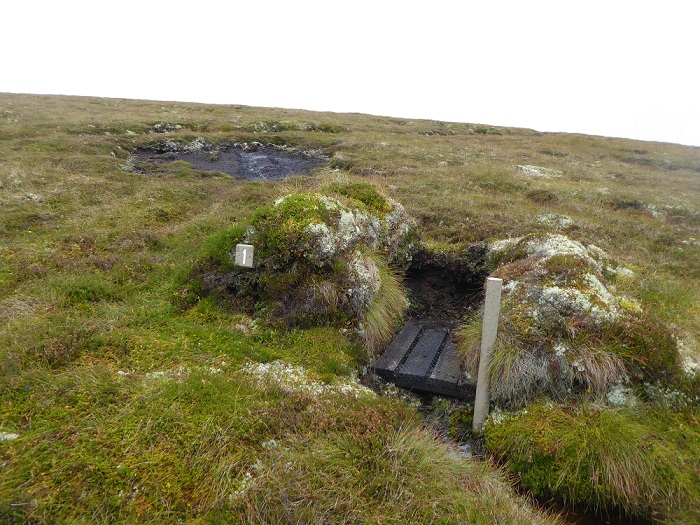
A line of grouse butts we followed had been constructed fairly recently by removing vegetation from the bog, leaving exposed areas of peat which then release carbon into the atmosphere.
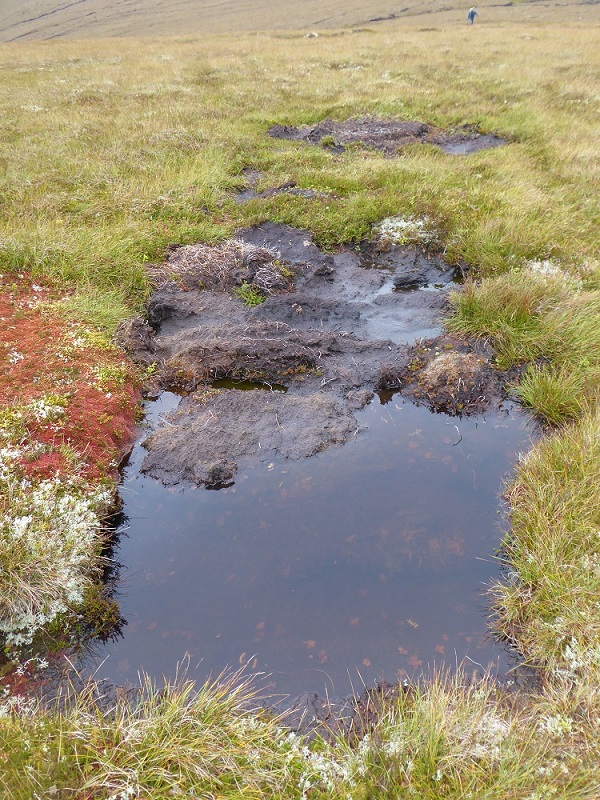
Medicated grit stations all over the hill had been created by cutting out blocks of turf leaving peat exposed to degradation and erosion.
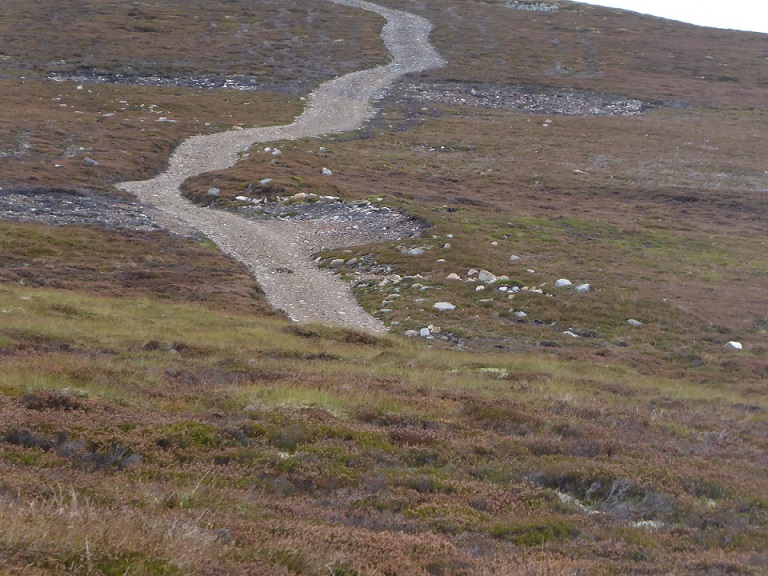
And, to add to the damage, the hill road up Carn Oighreag appears to have been upgraded in the fairly recent past. From the CNPA planning portal no planning application appears to have been submitted for this work or a new extension to the road on the col between Carn Oighreag and Brown Cow Hill. According to the case studies within the Final Report on the Cairngorms Nature Action Plan 2013-18 (see here) the estates involved in the East Cairngorms Moorland Partnership had agreed “to map current hill tracks and ensure early discussions on any future proposals”.

While it is unclear if Prince Charles is aware of what is being done in his name – one would have hoped he would have noticed while out grouse shooting – it appears at present that the estate cannot be relied on to honour its commitments. In my view, Peatland Action should be requiring the estate to repair all the damage it has done to bogs in the last twenty years before agreeing to pay out a penny of public money.
What needs to happen
Strangely, Delnadamph has so far remained out of the public eye. But the evidence from my visit shows that it is being managed in a way that is incompatible with the conservation objectives of the National Park. It is time that was addressed and one would hope that Prince Charles, given his oft stated commitment to conservation, would be prepared to do this. Perhaps as a first step he should invite Sir David Attenborough, with whom the Royal Family have been associating a lot recently, to visit the estate and advise on what needs to be done?
In my view that should include an immediate end to all muirburn and other practices associated with intensive grouse moor management, such as use of medicated grit, trapping and shooting of mountain hares. Given that deer are effectively fenced out of the estate, Prince Charles could then afford to leave the land for ten years – apart possibly from some walked up shooting -and see what happens naturally. The two keepers currently employed by the estate could be re-engaged as nature guides – tours around “Prince Charles’s great conservation project in the Cairngorms” would be very popular – and to work on restoring damage caused by estate management activities.
After ten years, the situation could be reviewed and consideration given to taking down the fencing and letting deer back onto the estate. Deer, after all, should be an integral part of the natural environment and not artificially excluded as happens over much of Donside.
I would hope that Prince Charles would be prepared to take radical action and change his shooting lifestyle for the sake of the natural environment. If not, however, there is a strong case for management of the estate to be handed over to the Cairngorms National Park Authority. When the Queen bought Delnadamph for a reputed £750k back in 1978, she was effectively able to do so because of the large public subsidies provided to the Royal Family. Their continued private wealth is a result of ongoing public financial support and I believe the public therefore should have a right to expect that Royal land is managed in a way that helps to address the global environmental and climate crisis, not make it worse. The Crown should have a statutory duty to promote nature conservation just like the National Park.

Disgraceful!
Very informative article. Thank you for enlightening the people about the failure to manage our beautiful countryside in an ecologically sound way.
On October 14th 2019 we witnessed 2 men on ATVs systematically shooting mountain hares. They were approximately 1km east of Brown Cow hill summit.
Thankyou! I am always slightly wary of making generalisations based on single observations but this helps confirm that systematic extermination of mountain hares is taking place on the estate
I live nearby on the Glenlivet Estate. Delnadamph is a disgrace and as you descend the road from The Lecht to Donside the landscape looks ravaged by unsightly muirburn. Yes, an opportunity for those with influence ie the Royal family to “ walk their talk” and reverse ecological and landscape quality .
Thank you fir this. It shows, as I have long suspected, Charles really doesn’t care about the environment, just about shooting things! The sooner Scotlandis a republic and we take this kind of land into public ownership the better. Charles and his family are arrogant leeches on the public purse.
Really good and informative article. I will be sharing it …and sharing it again. Thankyou.
I do not understand why conservation organisations fall over themselves to have royal patronage or aspire to be royal societies. Their commitment to conservation seems to go no further than the end of a shotgun and the sequestration of thousands of hectares of land to provide something to shoot.
It would be good if any members of WWF could write to WWF and ask them to call on their President to change the way he manages his land
Well observed and written. And with pointing out positive ways forward.
I agree that Prince Charles and other family members should be told clearly of their double standards. The Duke of Cambridge was appointed BTO Patron in Oct 2020 with similar concerns.
I think this post should be forwarded to HRH to his official residence and via the Factor of the estate for comment.
I was on the Balmoral Estate yesterday and there is plenty of room for woodland regeneration there too (alongside those poor aging single age pine clusters) – especially if the commercial plantations were removed. I guess though this is Queen country so not (yet) Prince Charles’s to deal with.
It’s a great sadness for me that great areas of our land is spoiled by being kept deliberately barren of wildlife for the purpose of killing things. The blanket forestry isn’t any better. Some people even think that it is our natural landscape.Surely we can do better than that! The article just reinforces my own observations-about these estates as well as about the royal family! I was so sickened by the thought of Prince William taking his small children to shoots.
That trap fail to conform to best practice guidelines. The entrance is 50mm and should be no more than 32.5mm.
An outstanding article that not only exposes the issues but offers achievable solutions.
When you’re on the tv going on about environmental sustainability and at the same time doing muirburn to artificially manipulate the land for one species to please shooting parties (flying in from multiple countries) the message comes across as rather hypocritical and extremely obnoxious
Thanks for this. Now who is going to tell Charles Windsor?
So what are we going to do about it? Margaret Clarke is right – we need to speak to Charles Windsor about this. And make it public. I don’t feel I know enough about it. But Charles should be confronted with this article at the very least. Hard to do though, I suppose…
Thanks Evi and Margaret, you are right. Ideally the Cairngorms National Park Authority should be demanding change and if they are not managing to do this through the East Cairngorms Management Plan – their communications with Balmoral should in my view be made public – should be asking the Scottish Government to support them in doing so. I will write to the CNPA about this. I have my doubts though the Scottish Government is up for change, we will see when they publish their response to the Werritty Review on grouse moor management. I think therefore everyone has a role to play: if you live in the CNPA area, write to your local Board Members (both councillors and directly elected) asking them to act; if you are a member of the WWF, ask them to act; if you live in Scotland, ask your MSP/s to commit to changing the way land in Scotland is managed. Prince Charles is at the apex of the system, so for those wanting to change it, there is no better place to focus efforts. I will also write to the palace and ask Prince Charles to come out for a walk with me – no harm trying! I am prepared to talk to anyone………………..
Prince Charles, What is happening on your Estate? You say we SHOULD PROTECT the ENVIRONMENT and WILDLIFE and you are ALLOWING this at a time when the PLANET is experiencing a MAJOR CLIMATE CHANGE PEAT BOGS are CARBON SINKS and they are being DAMAGE for GROUSE SHOOTING.SETTING TRAPS is INDEFENSIBLE as all wildlife has a right to live.SHOOTING of PROTECTED MOUNTAIN HARES is not only ILLEGAL but goes everything YOU SHOULD STAND FOR, it’s time the ROYAL FAMILY STARTED to LISTEN to the PUBLIC who find who find SHOOTING and HUNTING for SPORT ABHORRENT.
Unbelievable. If HRH won’t speak up and excercise moral authority then who will
Simply shared the post on https://www.facebook.com/balmoralcastle.
Very revealing and thorough, Nick, thanks. Resonated with me given lack of wild life observed at weekend on a walk in southern Scotland
Great article, highlights the issues and offers solutions as always. These areas used to hold Wildcat and although now unlikely for various reasons perhaps they could be reintroduced in the future as part of your suggested solutions? One issue is of course that there could still be some around but I strongly suspect this area was not touched during SNH’s claimed “national” surveys.
Sort it out Charlie
So its rather obvious that the muirburn code is not being applied. This should mean that no public funds eg peatland action, would be available. Why should the public pay to restore ditch damage only to allow fire damage to continue.
Burning juniper is astonishingly bad.
Looking at the photos accompanying the article there is grossly excessive muirburn so insufficent leggy heather for chick rearing .Much of the land is sphagnum bog or coarse grass that does not support heather growth so no use for Grouse .It has a north facing aspect again poor for chick rearing ,it is too elevated.It seems to be a desperate attempt to increase grouse shooting over unsuitable land .The Angus moors have a south facing aspect and are lower .I suspect the bags are poor. Medicated grit is a subject of its own if you like mebendazole in your grouse but its not supposed to be there.
The sooner we come to recognise the royals as a regressive, hypocritical and damaging anachronism the better. Remove their patronage from anything environmental, they’re not worthy.
Perhaps a quick glance across the western ocean this month? Shenanigans, mud-flinging, while the vast self-interested promotion costs, associated with just one alternative system for appointing a transient head of state, destablise everything economically. This process stymies most government processes every 4 years ? The past weeks should easily have convinced even the most hostile that leaving the decision about a politically circumscribed non executive head of state to “providence” is very sensible. Royal lineage is more efficient and easy to circumscribe by law. For taxpayers this is much cheaper, and can be adapted by public pressure each generation to continue hold itself above and beyond outside influence and commerce? Yet change the head of state system and these estates would still be run just as now across the highlands. After all it is Scottish land managers who effectovely operate them ?
Interesting points, But I don’t think the only alternative political / head of state system is an American one. We have nothing to learn from America. Perhaps the only answer is independence, although that is not something I’ve previously supported.
Interesting piece. Thought provoking and raises an issue that requires attention. Has anyone raised this issue with their MSPs/ the Scottish Parliament? Contact me directly if anyone wants to take this forward. I’ve worked at Holyrood since 1999. I help groups and charities to lobby MSPs and get their issues onto the parliamentary radar. It would be relatively easy to take this issue forward.
Scottish Greens are currently running a petition to encourage Scottish Government to declare a nature emergency this Wednesday. While I’m sceptical this will lead to much it will at least keep the issue on the agenda- worth taking a look. While The Royals talk a good talk on conservation they are steeped in the hunting/shooting /fishing lobby and an outdated Victorian vision of Highland Estates. They should be leading the way with the likes of Glenfeshie rather than preserving a form of outdated upland monoculture.
Any word from what’s his face yet ?too busy polishing war medals ok yes I see very well then move along now
Last weekend my wife and I went for a walk in the hills in the area near Corgarff Castle, on Donside. Starting near the castle, we were immediately impressed by the variety of bird life in the glen, on the flat ground by the river, where many lapwings, curlews, and oystercatchers called. Sand martins were in evidence darting over the meanders of the River Don. Heartened by the calls of the waders, we set off past the castle, up towards Brown Cow Hill.
Sadly, however the picture quickly changed. As we climbed to higher ground we found ourselves walking over a monotonous monoculture, of heather interspersed by areas of burnt ground. Barring the occasional red grouse, silence reigned. There was no other wildlife to be seen or heard. The smell of recent muirburning hung in the air. We were walking over a man-made desert. From the top of the hill it was clear that many surrounding hills were in the same state, with the ugly patchwork of heather and muirburned areas extending for miles.
I have extensive experience of walking the Scottish hills and have visited the area regularly, so none of this came as a surprise, but it is no less depressing for that. I have also walked in many European mountain areas, and the contrast is startling. The two most obvious things that one sees in Europe are that the hills are heavily wooded to quite high latitudes, and many people live and work among them.
I would suggest that the main reason for this is land ownership. We have in Scotland a situation where a small number of very rich landowners are free to use large areas of our country as they see fit, and their wish is to keep these estates as near to empty as possible and use them as playgrounds for themselves and their wealthy guests.
I do not deny that “sporting” estates provide some local employment, but surely if we could enable some rewilding and the introduction of more imaginative local infrastructure, such as more extensive walking and cycling trails, and more low cost accommodation, some of it well away from the road as is common in European mountain areas, the tourist appeal of areas like this could be greatly increased, and so could local employment. Much more of this income would also stay in the local area.
I also feel that it is important that in areas such as conservation and in tackling climate change, Scotland should lead by example. The regular burning of these mountain slopes must release a lot of unnecessary carbon dioxide into the atmosphere, and extensive restoration of natural forests could act as a large carbon sink. This would have the added advantage of providing far more and varied wildlife habitat.
One of the main reasons that I am favour of Scottish independence is so that we can have the powers to tackle the land ownership and use problems that so blight our rural areas and keep them depopulated.
As I final ironic twist to this tale, I heard on the news as I type, that HRH Prince Charles has encouraged the planting of millions of trees to honour the seventieth anniversary of the Queen’s reign. It so happens the Prince Charles owns the Delnadamph Estate on which I was walking this weekend! If he wants to plant some trees, I know where he should start.
I am 85 & was brought up in Corgarff,no longer live there .
As a child I remember wildlife being plentiful there in spite of game keepers doing their stuff .I even remember seeing an occasional live wildcat & sadly some dead ones hanging as trophies on a fence.
Mechanisation has wrought a lot of the damage, making access to remote areas easier & the machines used causing more damage
Grouse shooting was considered a sport for ” gentlemen” & not done for money . There were no tracks on the moors for vehicles & the shooters had to be fit and able to walk . At the end of a day’s shooting the bag of grouse was transported by ponies and panniers so less damage all round